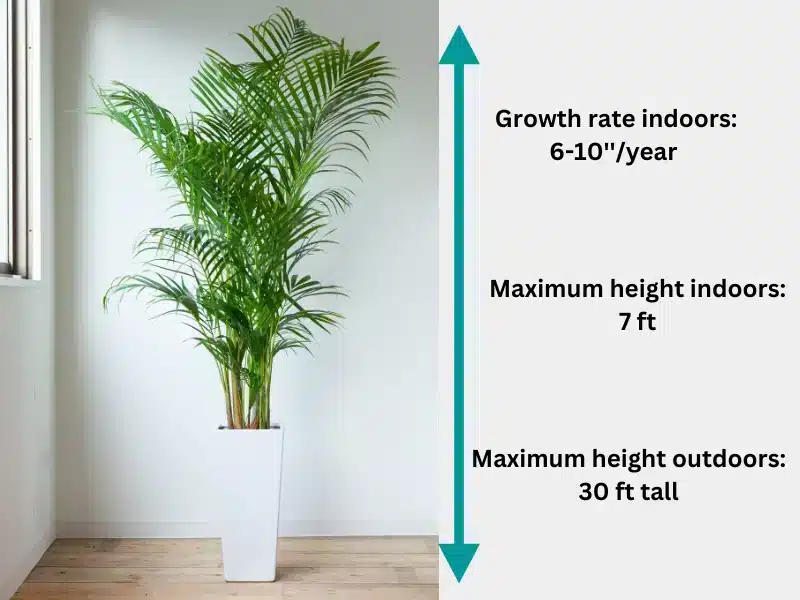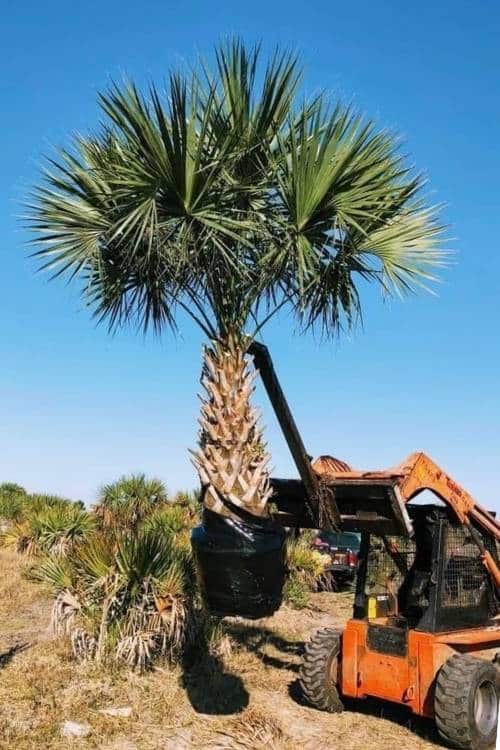Areca Palm Growth Rate: How Fast Does it Grow?
Under optimal environmental and soil conditions, areca palms grow faster to give your outdoor or indoor space the tropical flair you desire. But when these factors are unfavorable, you’ll notice that your palm grows slower than normal or stops growing.
Areca palms grow at a rate of about 6-10 inches yearly. A healthy indoor areca palm can grow up to 7 feet tall, while outdoor palms can reach 30 feet. A young areca palm seedling takes up to 10 years to grow to its full height.

Why is my areca palm growing slowly?
Below are the common reasons why your areca palm is growing slowly.
Low light
Plants need light to form chlorophyll, which helps make food through photosynthesis. Areca palms thrive under big trees with indirect, filtered sunlight in their natural habitat. Indoor or potted areca palms thrive in indirect sunlight.
An areca palm in a location with less or no sunlight doesn’t photosynthesize and thus develops problems such as yellow and brown leaves and grows slower.
Underwatering
Areca plants require regular watering to keep the potting soil moist for healthy development. However, underwatering dries out the soil, and the plant gets insufficient water. Physiological processes like photosynthesis and the transportation of minerals and nutrients don’t occur efficiently.
Additionally, insufficient water weakens areca palm roots. As a result, the plant develops curled leaves, yellowing and browning leaves, drooping, and grows slower.
Overwatering
Areca plants thrive in moist soils. However, overwatering your palm makes the soil soggy or overly moist, leading to root rot.
When sitting in soggy soil, the fronds turn yellow and brown, and the plant grows slowly.
Pest and diseases
Pests such as mites, mealy bugs, caterpillars, and spider mites are common in areca palms. They prick the palm’s cell tissues and suck the cell sap. Continuous feeding causes browning fronds and slower growth.
Diseases such as leaf spots cause stunted growth in areca palms and other types of indoor palms.
According to the University of Florida, leaf spot results from various fungi living on the plant. Such fungi include Phaeotrichoconis, Pestalotia, Bipolaris, Cercospora, Stigmina, Colletotrichum, Calonectria (Cylindrocladium), Gliocladium, Pestalotiopsis, Phyllachora, Pseudocercospora, Annellophora, and Exserohilum. (Source)
An areca palm suffering from leaf spot disease starts showing small, brown spots surrounded by water-like dots.
If the disease is not controlled, the spots spread, making the leaves brown, and the plant’s growth rate becomes slow.
Nutrient deficiency
Areca psalms require nutrients such as nitrogen, potassium, and phosphorus to grow healthier and faster. These nutrients help in plant processes such as transpiration, transportation, photosynthesis, respiration, and the growth of new leaves.
However, insufficient nutrients cause yellowing and browning leaves and stunted growth.
Additionally, insufficient nutrients deter new leaves from growing, while old ones drop off the plant.
Low temperatures and humidity
Areca palms thrive in warmer locations with enough air moisture. An optimal temperature for a potted areca palm is 65-75°F and 50-70% humidity. Temperature below 45°F and low humidity deter physiological processes, leading to slow growth.
Your plant is root bound
Potted areca palms become root bound after some time. As the plant grows in the container, it develops more roots that spread downwards and outwards to absorb more water and nutrients. The roots also grow bigger to support the increasing mass of the plant.
As the roots spread, they take up more space in the container until there’s no more left. They thus intertwine with each other, pass through the drainage holes, or grow backward and upwards in the container.
A rootbound plant dries quickly, even after watering. Consequently, it grows slowly.
How to make areca palms grow faster
Here’s how to make areca palms grow faster:
1. Water the plant correctly
Watering your areca palm regularly ensures the potting mix remains moist; thus, the plant can carry out physiological processes that promote fast growth. Areca palms thrive when watered regularly to retain soil moisture.
Water the areca palm when the top two inches of soil are dry. To check the moisture level, dip your finger or a screwdriver into the potting mix and observe stuck soil particles. Water immediately if your finger or screw is dry.
Water until excess water flows through the drainage holes at the bottom of the pot. The soil or potting mix should have good drainage to avoid causing root rot disease.
2. Place the palm in a spot with indirect light
A suitable location ensures the plant gets enough light and temperature. With optimal light and temperature, the plant grows healthy and faster.
Place your areca palm container away from direct sunlight to solve the light problem. East, west and south-facing windows are the best planter placement spots. If your room receives direct sunlight, add sheers to your windows to filter the sun before it reaches the plant.
Keep the plant away from air vents or conditioners to prevent cold drafts that cause browning and stunted growth.
Remove the plant from heat sources such as furnaces and fireplaces to avoid unfavorable high temperatures.
3. Add a humidifier to your room
You can correct stunted growth from low humidity by adding a humidifier to the room with the areca palm. A humidifier increases the air moisture and creates a microclimate that supports faster growth. Also, bring the plants close to each other to increase humidity levels.
4. Mist and wipe the areca palm often
To deal with pests that cause stunted growth, mist and wipe your areca palm to remove them. Misting washes the pests away and increases humidity. Dip a cloth in neem oil or insecticidal soap and wipe the stem and fronds of your palm. Wiping with neem oil removes the pests and keeps them away.
Maintaining optimal environmental conditions makes it difficult for fungi to invade your plant and cause leaf spots.
5. Fertilize the plant regularly
Areca palms require regular feeding to grow faster. Fertilize your plant every two months when it’s actively growing in spring and summer with half the recommended amount to avoid burning. Remember to follow instructions during the application.
A good palm fertilizer for areca palm is one with high levels of nitrogen and potassium but low phosphorus. For example, a slow-release fertilizer of an NPK ratio of 8-2-12. You can also use epsom salt to help the plant grow faster.
Repot the areca palm
Repot root-bound areca palms in a bigger container after every two years to promote faster growth. The best time to repot is spring.
Here’s a step-by-step guide to repot a root-bound areca palm.
- Select a new pot 3-4 inches wider than the current one. The pot should have enough drainage holes underneath to avoid water logging.
- Fill in the new, empty pot with soil or potting mix. Add little soil up to where you’ll place the roots. Build a small mound at the center to mark this point.
- Carefully remove the areca plant from the old container. Avoid pulling the plant or grabbing it by its stem or fronds. Instead, hold the plant by the base of the soil and turn the pot downwards, so the plant falls on your hand. Water it a day before repotting to make the plant come off easily.
- Check the roots for diseases or damage and cut them with shears or a garden knife.
- Prune the roots, removing those that are intertwined or those growing upwards.
- Add the plant to the new container with soil. Place the roots on the mound and spread them outwards – away from the stem – to create space for water movement.
- Add more soil or potting mix to the container, leaving the crown slightly above the soil.
- Add a mulch layer on the soil surface and water the plant lightly.
How fast do areca palms grow outdoors?
Areca palms are fast-growing plants. When planted outdoors under optimal environmental and soil conditions, an areca palm adds about 6-10 inches annually, according to Karen Russ and Al Pertuit, PhD, Emeritus Faculty, Horticulture, Clemson University. (Source)
An areca palm seedling can take up to 10 years to reach maturity size.
How big do areca palms get?
Areca palms can grow as tall as 30 feet in their natural habitat or when grown outdoors. However, indoor areca palms grow shorter than outdoor ones. On average, a mature indoor areca palm grows up to 7 feet tall.
Wrapping up
Under optimal environmental and soil conditions, areca palms grow fast, adding about 6-10 inches yearly. However, when these conditions are unfavorable, the plant gets stressed and thus grows slowly.
If your areca palm is growing slower, diagnose the cause and apply the correct measure to help it recover.
When treated correctly, an areca palm suffering from stunted will recover and grow faster.
References
- The University of Florida Extension: Leaf spot and Leaf Blight of Palm.
- Oregon State University: Environmental Factors Affecting Plant Growth.



